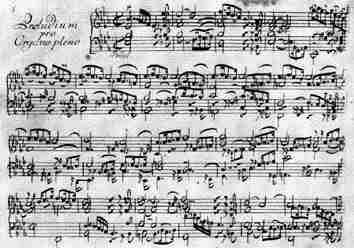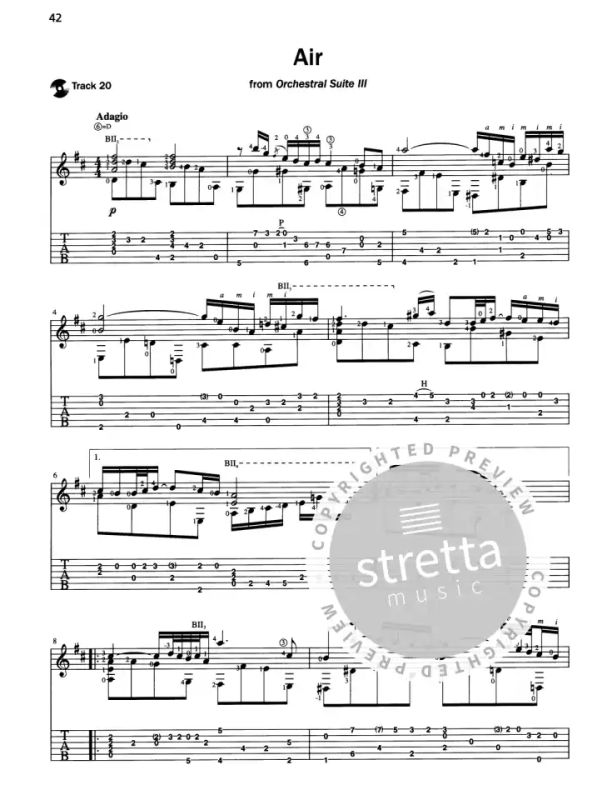

BWV 1070 – Orchestral Suite in G minor by an unknown composer.4 in D major (for oboes, bassoon, trumpets, timpani, strings and continuo) Movements: (no description, two sections), Bourrée I & II, Gavotte, Menuet I & II, Rejouissance 3 in D major (for oboes, trumpets, timpani, strings and continuo) Movements: (no description, two sections), Air, Gavotte I & II, Bourrée, Gigue 2 in B minor (for traverso, strings and continuo) Movements: (no description, two sections), Rondeau, Sarabande, Bourrée I & II, Polonaise & Double, Menuet, Badinerie 1 in C major (for woodwinds, strings and continuo) Movements: (no description, two sections), Courante, Gavotte I & II, Forlane, Menuet I & II, Bourrée I & II, Passepied I & II


BWV 1058 – Concerto for harpsichord and strings in G minor (after BWV 1041, Violin Concerto in A minor).BWV 1057 – Concerto for harpsichord, two recorders and strings in F major (after BWV 1049, Brandenburg Concerto No. 4 in G major).

BWV 1056 – Concerto for harpsichord and strings in F minor.BWV 1055 – Concerto for harpsichord and strings in A major.BWV 1054 – Concerto for harpsichord and strings in D major (after BWV 1042, Violin Concerto in E major).BWV 1053 – Concerto for harpsichord and strings in E major.BWV 1052.2, formerly BWV 1052 – Concerto for harpsichord and strings in D minor (revised version).BWV 1052.1, formerly BWV 1052a – Concerto for harpsichord and strings in D minor.Main article: Keyboard concertos by Johann Sebastian Bach BWV 1051 – Brandenburg Concerto No. 6 in B-flat major for two violas, two violas da gamba, cello and continuo.BWV 1050.2, formerly BWV 1050 – Brandenburg Concerto No. 5 in D major for harpsichord, violin, traverso and strings.BWV 1050.1, formerly BWV 1050a – Concerto in D major for harpsichord, violin, traverso and strings (early version of Brandenburg Concerto No. 5).BWV 1049 – Brandenburg Concerto No. 4 in G major for violin, two fiauti d'echo (recorders), strings and continuo.BWV 1048 – Brandenburg Concerto No. 3 in G major for three violins, three violas, three cellos and continuo.BWV 1047 – Brandenburg Concerto No. 2 in F major for trumpet, oboe, recorder, violin, strings and continuo.BWV 1046.2, formerly BWV 1046 – Brandenburg Concerto No. 1 in F major for violino piccolo, three oboes, bassoon, two corni da caccia, strings and continuo.BWV 1046.1, formerly BWV 1046a, originally BWV 1071 – Sinfonia in F major (early version of Brandenburg Concerto No. 1).BWV 1043 – Double Concerto in D minor for two violins.BWV 1042 – Violin Concerto in E major.BWV 1041 – Violin Concerto in A minor.Weimar concerto transcriptions, BWV 592–596 and 972–987.Apart from the concertos for more than one performer listed in the sections below, Bach also wrote concertos for a single unaccompanied harpsichordist or organist: In the 19th-century, the Bach-Gesellschaft published Bach's concertos BWV 1041–10–1065 as chamber music – the designation as orchestral music becoming more common in the second half of the 20th century. Such orchestra of the Baroque era can be indicated as string orchestra or chamber orchestra. The orchestra of the concertos for one or more accompanied soloists ( BWV 1041–1044, 1049–10–1065) consists in most cases of strings (two parts for violins and one viola part) and continuo (for example performed on cello and harpsichord). Main article: List of concertos by Johann Sebastian Bach


 0 kommentar(er)
0 kommentar(er)
